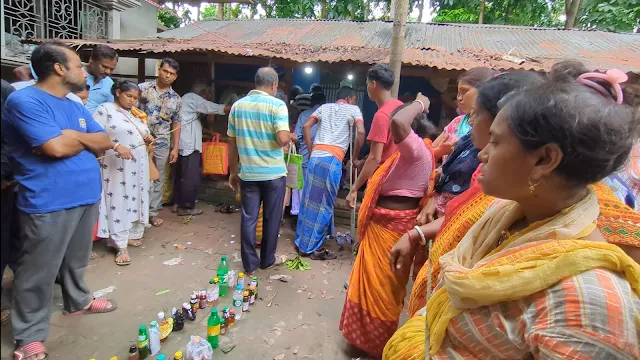 ✍️ রাজু বিশ্বাস (Ranaghat, Nadia)
✍️ রাজু বিশ্বাস (Ranaghat, Nadia)

✤ Introduction
Bengal has long supported indigenous healing systems that are based on oral traditions, natural remedies, and local beliefs. Many people still use these tried-and-true folk remedies in addition to contemporary medicine today.
A woman who almost everyone refers to as "Harbhanga Buri ma"—the Bone-Healing Grandma—lives in the sleepy village of Ghoshpur Mathpara, close to Maslandapur in North 24 Parganas. Her true name, Lakshmi Mondal, has become obscure. But her reputation is still going strong because people still think she can use herbal oils and sacred chants to treat body aches, joint pain, and broken bones.
✤ Getting There: Travel & Accessibility
Travel by train to Maslandapur Railway Station to see this fabled healer. Local van drivers shout out loudly from Platform No. 1: "Harbhanga Burima! "Harbhanga Burima."
It takes ten to twelve minutes to get to Ghoshpur on a motorized van or shared bicycle. The typical fare is ₹15 per person, but if there are fewer people traveling, the price may go up by ₹5 to ₹10.
✤ Who is the “Bone-Healing Grandma”?
It is estimated that Lakshmi Mondal is in her late 60s or early 70s. She has eight children—four sons and four daughters—and leads a simple life with Shimul, her youngest son, who now helps her with her healing techniques. According to locals, she left modern-day Bangladesh almost 40 years ago.
According to legend, a family member once had a dream in which they received a divine revelation that revealed the root of a rare medicinal plant and gave them a mystical chant, or "mantra." This was the start of a generation-long healing custom. According to Lakshmi, she has been practicing this folk remedy for three generations.
✤ Healing Method & Types of Illness Treated
Burima relies on two primary techniques for healing:
1. Phu's Blowing Chant
Locals believe that the air she blows onto the injured area while chanting sacred verses has the ability to heal spiritually.
2. Massage with Herbal Oil
She adds a proprietary herbal extract to the mustard oil that patients bring. To lessen discomfort and swelling, the oil is then massaged into the afflicted area.
👉 She occasionally suggests X-rays, calcium supplements, or seeing a doctor in addition to conventional techniques.
👉 She is especially known for treating:
💢Broken bones
💢Sprains and dislocations
💢Joint and waist pain
💢Asthma
💢Piles (Hemorrhoids)
💢Skin diseases
⏰ Clinic Hours:
Tuesdays and Saturdays are open.(Saturdays are particularly busy.) 5:00 AM to 6:00 PM.
✤ Payment & Community Trust
Dakshina matro sholo ana, or "Her fee is just goodwill," is a common saying among the locals. She never asks for money. Donations of ₹10, ₹50, or even ₹100 are voluntarily left by patients and placed in a cane basket close to her hut.
✤ Social and Cultural Impact
She is sought after for healing by people of all faiths, including Muslims and Hindus. People from Habra, Barasat, Basirhat, Nadia, and even other states are drawn to her because of her fame, which extends well beyond Maslandapur.
✤ Economic Ripple Effect: A Rural Micro-Economy
The influx of patients every week has transformed Ghoshpur into a local economic hub:
👉 10–12 small shops have grown around her home
👉 Street food stalls selling puffed rice, ghugni, and snacks
👉 Tea and tiffin counters for waiting patients
👉 Bottled mustard oil stalls (₹10–₹50 per bottle)
👉 Van/toto parking and charging stations
This alternative medical practice has sparked rural employment and entrepreneurship—without any formal clinic or license.
✤ Faith and Science: A Comparative Analysis
✤ Legacy and Upcoming Generation
Shimul, the youngest of Lakshmi's eight children, is pursuing a career in healing. "We don't farm this healing root," he states. It loses its power if it is cultivated, as Grandma used to say. Thus, we gather it from garden corners, old field edges, and wooded pathways.
Both Muslims and Hindus visit with equal faith, demonstrating that the custom transcends religious boundaries.
🎥 Watch: Harbhanga Burima – A Miracle in Bengal’s Folk Healing Tradition
This video explores the life and practices of 'Harbhanga Burima', an elderly woman from Ghoshpur village who is locally known for healing bone fractures, joint pains, and other ailments using herbal oils and mystical chants. Discover how faith and tradition come together in this living legacy of folk medicine.
✤ Final Thoughts
"Harbhanga Burima" is more than just a folk healer; she is a representation of the micro-level economy, cultural continuity, and rural resiliency.
Her techniques are rooted in long-standing customs that combine spirituality and economics, as well as healing and belief. She stands for the silent persistence of indigenous knowledge, preserved by faith, family, and folklore in a rapidly modernizing world.








We welcome thoughtful discussions. Comments are moderated for quality